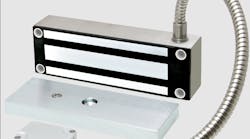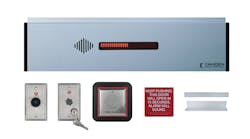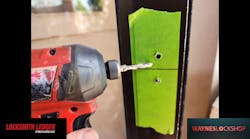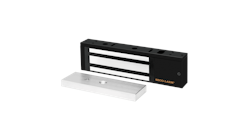For years, electromagnetic locks, or maglocks, were used before building codes were written, which led to tragedy. Fortunately, that situation has changed, and today’s maglocks adhere to ANSI/BHMA standards for operation and UL standards for safety.
Bear in mind, however, that even with guidelines in place, a maglock can be installed improperly. Without inspection for compliance and enforcement of the codes, owners and mechanics might cut corners out of ignorance or greed, which could result in potential death traps.
In our July issue, we discussed maglocks with regard to code. In this article, we’ll look more closely at installation and mounting, as well as note a few features of maglocks you should keep in mind.
Forcing the Issue
Magnetic holding force, of course, is one of the parameters used to compare different models of maglocks. Small maglocks are rated at 600 pounds, with larger models rated at 1,200 and even 1,500 pounds.
Shear locks are similar to maglocks, but they also incorporate the other fundamental interaction, gravity, in addition to magnetism. Therefore, the holding force of a shear lock is the combined holding force of the electromagnet and the hold of the interlocking faces of the shear lock.
However, the holding force of maglocks and shear locks are dependent on the surface contact between the maglock and the armature, as well as the consistency and quality of the voltage applied. The holding force also is dependent on the sturdiness of the armature and electromagnet. In other words, installation can affect this parameter.
Electromagnets typically are mounted at the top of the door, and if the door is flexible, such as an aluminum storefront door, oscillating the door in the frame could weaken the bond.
We once were called to install two 1,500-pound maglocks on the vertical edge of a metal fire door that was used to confine wayward adolescents. The adolescents were able to exert enough force to pop open the door having just one maglock on it. Surely, the holding force of the maglocks was affected by contamination to the mating surfaces and possible line-voltage fluctuations, but it’s illustrative of the necessity of good maintenance along with good installation.
We recently asked Mason Stacy, DHT, DHC, CDI, who is a specification consultant for Allegion, about the most common issues authorities having jurisdiction experienced with regard to installing maglocks. This was his answer:
“The fact that magnetic locks are fail-safe can be an issue. Sometimes, I will see storefront doors left mechanically unlocked. If power drops, the magnetic no longer will secure that door. I feel a little silly saying this, but make sure the end user knows they shouldn’t rely on the electromagnetic lock to secure the building after hours and that it should mechanically lock as well.
“Also, be careful with the placement of the motion sensor. I’ve seen where an internal stairwell door was near the exterior door that had an electromagnetic lock. People going into the stairwell were unintentionally walking into the sensor’s range and unlocking the exterior door.
“Regarding motion sensors mounted above the door, someone could wedge something through the door and trigger the sensor. This would be a problem particularly on tall doors secured by an electromagnetic lock, because the door would have a lot of flex whenever it wasn’t mechanically latched.”
Maglock Mounting
So, there’s a lot to consider when it comes to the installation of a maglock. Proper mounting is essential, and there are three types of mounts.
On surface-mounted maglocks, the bolts go through the maglock and secure into the door frame. Often the cabling for the maglock is sealed into the body. When you secure the maglock to the door frame, you must pass the maglock’s cable through a hole to its designated destination — the controller or power supply. If eventually it becomes necessary to remove the maglock, you must disconnect the cable from the controller or power supply that has been snaked into the frame. (Or, you can cut it altogether.) It will be time-consuming to dislodge, remove and then reinstall a new cable.
Face-mounted maglocks have flanges for attaching the maglock. The maglock must be mortised into the frame.
Bracket-mounted maglocks use a channel that mounts to the door frame. The maglock then attaches with fasteners to the channel. Although mounting the channel involves a separate step, it permits the frame to be prepped first and helps to locate the bracket more accurately for optimum alignment between the maglock and the armature prior to attaching the electromagnetic lock. Bracket mounted maglocks frequently have an access plate that’s removed to reveal terminal strips for power and optional feature wiring.
Installing a bracket-mounted maglock is also a bit less strenuous, because the bracket is light and easy to attach to the door frame. Several fasteners are used to attach the bracket to the frame, which helps to ensure stability. The maglock “keys” into the bracket and is held in position while you install fasteners between the magnet and the bracket.
The fasteners that hold the maglock to the bracket normally are machine thread screws that go into tapped holes in the bracket. Surface-mounted maglocks might allow for the use of other types of bolts for attachment, depending on the material onto which you’re installing the maglock.
Expanding rivnuts sometimes are provided with the installation hardware, and these rivnuts must be installed first. Rivnuts also are referred to as “blind nuts” and are installed with an installation collapsing tool or a special kit of hardware that’s included with the bracket.
Rivnuts are designed to secure into sheet metal, which is used on door frames and storefront doors, and allow the use of mounting hardware that will thread into the rivnuts and hold with more than a single thread, as would be the case with sheet-metal screws. Rivnuts work well if installed properly.
It’s important that the proper brackets be available to make for a professional, time-efficient, attractive and functional installation. Brackets often are designed and sold for specific models of maglocks. Carefully surveying the door’s frame and face ahead of time is essential so you show up to the installation prepared with the correct mounting accessories.
Metalwork for in-swinging installations and different frame door profiles are helpful and big time-savers. Brackets also can serve as spacers between the maglock and the frame and can have chambers for wire splices.
Armature Mounting
If there’s a “moving part” on a maglock, it’s the armature.
Typically, the armature has a big hole in the center, and the mounting bolt passes through the armature into an internally threaded through bolt, also known as a sex bolt. This bolt passes through the top of the door from the outside and provides a secure mounting.
The armature is heavy, and if it falls off the door, a pedestrian could be injured and, of course, the maglock no longer will lock. We got sued once by a woman who got hit in the head with an armature, so it could happen. In some jurisdictions, small cables are attached between the ends of the armature and the door frame to prevent this from happening.
Some maglocks also provide threadlocker compound with the sex bolt. Does it work? Yes. I recall only the one lawsuit after installing several thousand maglocks.
There are many mounting variations for mounting armatures, because installing a sex bolt isn’t always possible. On aluminum storefronts, there often is a big threaded rod in the channel at the top of the door that runs the width of the door and is often in the path of the sex bolt. This long screw is part of the door’s design and is integral to the door’s conforming with code.
Some maglock manufacturers have special products or solutions for armature mounting. These include tapping into the door frame and not going through the door channel, or adapter plates that fasten to the face of the door. For doors that don’t have frames or channels, such as herculite doors, two options are special U-Channels and super-glue kits. A note of warning about the latter: After the glue cures, it isn’t going to come off.
At some point in my maglock installation career, I determined that using a maglock product that was supported with a good selection of mounting accessories was the way to go.
In addition to saving me trips to the home center, it also would do the following:
- Save me the trouble of creating custom bracketry.
- Ensure a faster, more efficient install.
- Ensure the maglock and armature were more likely to be fastened securely to the frame and the door and, thus, hold the door more securely.
- Ensure the completed project would look more professional and less a DIY special.
Additional Features
Many maglocks are offered with multiple levels of security sensors, including door position, power to maglock and bond sensing. A few accessories can affect the installation process.
Conduit Fittings: For outdoor and special situations where it’s more advantageous to use conduit for wiring the maglock, models are offered that have a conduit fitting. Metal, PVC or seal-tite conduit can be used for exterior gates or mounting on cinderblock walls.
This is a welcome alternative to snaking and concealing your wiring while still affording it the necessary protection. The conduit provides protection against water and vandalism.
Annunciators: Lights and noisemakers can add sizzle to the steak, as well as dollars to your bottom line. Once, we installed a maglock along with a card reader system, and got a callback. The customer told us it wasn’t working and demonstrated how: After using a valid credential, system users would stand there without doing anything. After a while, they finally would try to enter. However, they had waited long enough for the maglock to time out and ended up pulling on a locked door. People are used to a buzzing sound to signal that the door was unlocked, but, of course, the maglock didn’t make any noise when it unlocked.
So we wired in a relay and snaked a buzzer into the door frame so it would make an audible signal to indicate the maglock was unlocked. You can get signaling appliances built into your maglock or wall-mounted ones to put adjacent to the door.
Annunciators can provide indication to passing security guards that a door is secure. If so wired, they also could indicate the door was ajar or that some other fault condition existed on the door that warranted attention.
Tim O’Leary is an experienced security consultant and a regular contributor to Locksmith Ledger.






